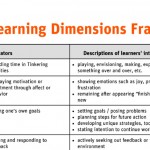In this video, Professor Ethan Danahy from Tufts University provides insights to his philosophies of assessment within his first-year intro-to-engineering course on robotics (using LEGO MINDSTORMS and LabVIEW Graphical Programming) and the techniques he uses for numerically evaluating his students throughout the semester.
In evaluating group projects, a midterm exam, and leveraging peer evaluation, Prof. Danahy employs a variety of methods for providing formative and summative feedback (qualitative and quantitative) to his undergraduate students.
The following two tabs change content below.


Rob Torok
I'm a teacher in Tasmania, Australia, and have been using LEGO MINDSTORMS with my students since 2001. I'm the editor in chief for LEGO Engineering (this site) as well as the content editor for LEGO Education Australia (LEGOeducation.com.au).
Latest posts by Rob Torok (see all)
- Obstacle Course - 26 August 2020
- Crash Test Dummy - 26 August 2020
- The Wave - 21 May 2020
- Build X - 20 May 2020
- Build a Duck - 20 May 2020



Thanks Ethan for posting this. I’m always struggling with how to grade and usually run into this: the absolute best “grading” I can do is providing individual feedback to students in a one on one setting. But that doesn’t go well on a report card. Our district uses an A, B, C, I grading system where B means meeting standard, A is exceeding, C is approaching and I is incomplete – either referring to actual missing work or missing the standard. I try to create my rubrics accordingly. For example in my latest project, “Make it Move Using Linkages” my grading is as follows:
An A would indicate the robot and linkage(s) used for movement are totally of the students’ own design. The robot moves well and doesn’t fall over or get stuck, and results are repeatable.
A B would indicate that the robot moves using a linkage but part of the design of the ‘bot or the linkage or both may borrow from an existing design. The robot may wobble or not move consistently in the same manner.
A C would indicate the robot has a linkage and sort of makes a forward movement, but is not quite there yet.
And an I means the robot is simply not finished at all.
This type of grading makes it easy for me as a teacher to grade 33 students quickly as they go through a series of projects in my 13 week course. But it does leave a lot out.
Recently I’ve started adding some student created assessments for example with my drag racing unit. You have to have a drag racer that uses meshed gears to increase acceleration. After that I let my students decide what the time over a 20 ft. distance will have to be for an A, B, and C. Usually this occurs after they have run a few trials with their drag racers. It is quite interesting how honest they are though, they don’t make it easy for the whole class to score an A.
One thing that I haven’t done but would really like to add is the peer grading you suggest via the astronaut example with the $100. I thought that was quite brilliant.
The last factor in grading that I want to address is the type of class. My class is an “exploratory” meaning that all 7th graders are required to take a trimester of Robotics. Given that I want to make them excited about Robotics while learning, I don’t want to be too “tough” with my grading system.